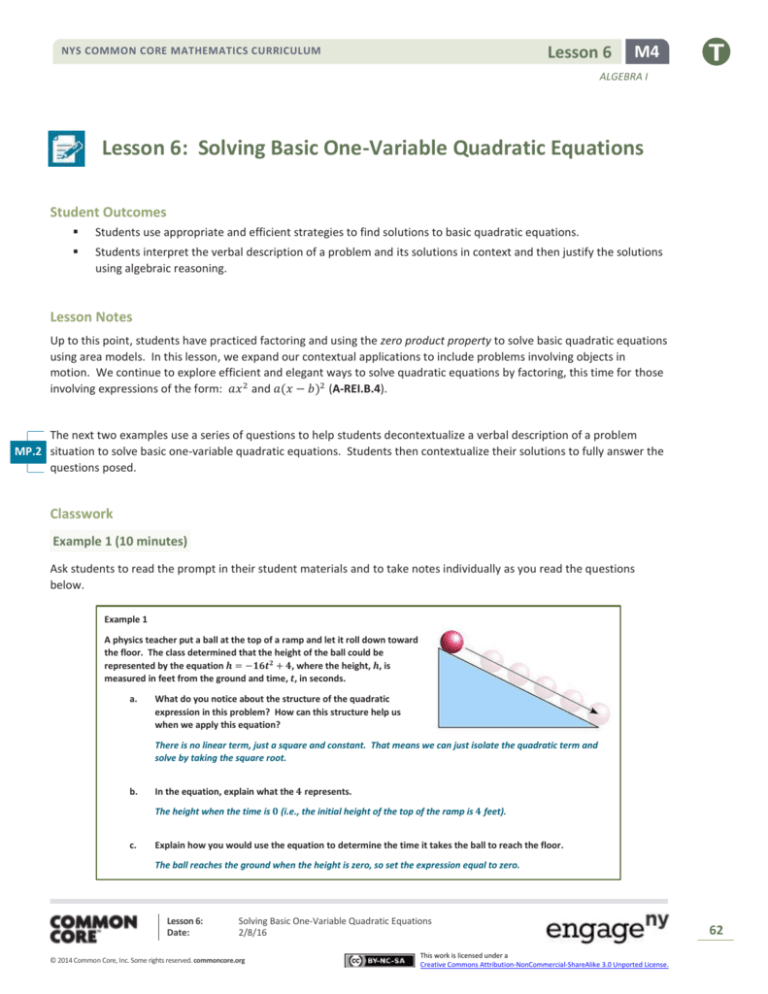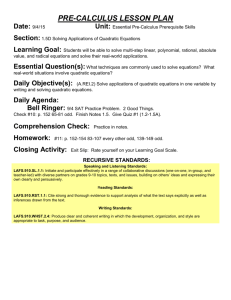
Lesson 6
NYS COMMON CORE MATHEMATICS CURRICULUM
M4
ALGEBRA I
Lesson 6: Solving Basic One-Variable Quadratic Equations
Student Outcomes
Students use appropriate and efficient strategies to find solutions to basic quadratic equations.
Students interpret the verbal description of a problem and its solutions in context and then justify the solutions
using algebraic reasoning.
Lesson Notes
Up to this point, students have practiced factoring and using the zero product property to solve basic quadratic equations
using area models. In this lesson, we expand our contextual applications to include problems involving objects in
motion. We continue to explore efficient and elegant ways to solve quadratic equations by factoring, this time for those
involving expressions of the form: 𝑎𝑥 2 and 𝑎(𝑥 − 𝑏)2 (A-REI.B.4).
The next two examples use a series of questions to help students decontextualize a verbal description of a problem
MP.2 situation to solve basic one-variable quadratic equations. Students then contextualize their solutions to fully answer the
questions posed.
Classwork
Example 1 (10 minutes)
Ask students to read the prompt in their student materials and to take notes individually as you read the questions
below.
Example 1
A physics teacher put a ball at the top of a ramp and let it roll down toward
the floor. The class determined that the height of the ball could be
represented by the equation 𝒉 = −𝟏𝟔𝒕𝟐 + 𝟒, where the height, 𝒉, is
measured in feet from the ground and time, 𝒕, in seconds.
a.
What do you notice about the structure of the quadratic
expression in this problem? How can this structure help us
when we apply this equation?
There is no linear term, just a square and constant. That means we can just isolate the quadratic term and
solve by taking the square root.
b.
In the equation, explain what the 𝟒 represents.
The height when the time is 𝟎 (i.e., the initial height of the top of the ramp is 𝟒 feet).
c.
Explain how you would use the equation to determine the time it takes the ball to reach the floor.
The ball reaches the ground when the height is zero, so set the expression equal to zero.
Lesson 6:
Date:
Solving Basic One-Variable Quadratic Equations
2/8/16
© 2014 Common Core, Inc. Some rights reserved. commoncore.org
This work is licensed under a
Creative Commons Attribution-NonCommercial-ShareAlike 3.0 Unported License.
62
Lesson 6
NYS COMMON CORE MATHEMATICS CURRICULUM
M4
ALGEBRA I
Show the chart below or work through the two methods on the board or screen. Have students compare the two
methods and discuss them with a partner or small group before asking the next three questions.
I came up with two methods for finding the seconds it takes the ball to reach the ground. Compare the two
solutions. Which solution uses the structure of the expression? How is the structure used? Which solution is
the most efficient?
Method 1
Method 2
Set the expression equal to zero:
−16𝑡 2 + 4 = 0.
Set the expression equal to zero:
−16𝑡 2 + 4 = 0.
Add −4 to both sides of the equation:
−16𝑡 2 = −4.
Factor out the GCF:
−4(4𝑡 2 − 1) = 0.
Divide both sides by −16 and take the square root:
2
1
1
4
2
𝑡 = , so 𝑡 = −
1
or .
2
(Discuss the need for both positive and negative values
and the use of the ± symbol. Advise students to
remember that the symbol represents two different
numbers.)
(You could also factor out −16 to give
1
4
−16 (𝑡 2 − ). Do you see the difference of perfect
squares? However, it is usually advisable to work with
integers rather than fractions when you have a choice.)
Factor the difference of squares:
−4(2𝑡 + 1)(2𝑡 − 1) = 0.
Now use the zero product property:
(Point out that it is only necessary to consider the two
variable factors since −4 cannot equal 0.)
2𝑡 − 1 = 0, so 𝑡 =
1
1
OR 2𝑡 + 1 = 0, so 𝑡 = − .
2
2
1
1
2
2
Therefore, 𝑡 = − or .
Some students may prefer the second method. It is important to point out that neither is wrong. But, also point out
that method 2 takes more steps and involves two types of factoring. Method 1 may seem more straightforward, but it
does not work for every quadratic equation. It only works when there is no linear term. It is the mathematician’s goal to
find the most efficient, and sometimes most elegant, path to a solution. (Remind students to always keep in mind the
negative solution when they take the square root of a square.)
d.
Now consider the two solutions for 𝒕. Which one is reasonable? Does the final answer make sense based on
this context? Explain.
𝟏
𝟐
Only 𝒕 = + makes sense since time cannot be negative in this context. This means that it took
𝟏
𝟐
sec. for the
ball to travel to the end of the ramp. That would make sense if the ramp was pretty short.
As you finish this problem, be sure to cross out the negative solution to emphasize that it is not applicable for this
context.
Lesson 6:
Date:
Solving Basic One-Variable Quadratic Equations
2/8/16
© 2014 Common Core, Inc. Some rights reserved. commoncore.org
This work is licensed under a
Creative Commons Attribution-NonCommercial-ShareAlike 3.0 Unported License.
63
Lesson 6
NYS COMMON CORE MATHEMATICS CURRICULUM
M4
ALGEBRA I
Example 2 (10 minutes)
Scaffolding:
Have students read the first part of the prompt in the student materials. Then, read and
answer the questions that follow. Students might work with a partner or small group to
answer the questions initially, but they should be ready to work independently for the
exercises that follow. Encourage independent thinking.
Example 2
Lord Byron is designing a set of square garden plots so some peasant families in his kingdom can
grow vegetables. The minimum size for a plot recommended for vegetable gardening is at least
𝟐 𝐦 on each side. Lord Byron has enough space around the castle to make bigger plots. He
decides that each side will be the minimum (𝟐 𝐦) plus an additional 𝒙 𝐦.
a.
What expression can represent the area of one individual garden based on the
undecided additional length 𝒙?
(𝒙 + 𝟐)𝟐
b.
There are 𝟏𝟐 families in the kingdom who are interested in growing vegetables in the
gardens. What equation can represent the total area, 𝑨, of the 𝟏𝟐 gardens?
𝑨 = 𝟏𝟐(𝒙 + 𝟐)𝟐
c.
If the total area available for the gardens is 𝟑𝟎𝟎 𝐬𝐪. 𝐦, what are the dimensions of
each garden?
𝟏𝟐(𝒙 + 𝟐)𝟐 = 𝟑𝟎𝟎
This example is highly
scaffolded for struggling
students.
For an extension, you
might have students draw
the design for the garden
plots that uses closest to
the 300 sq. m allotted but
also includes a narrow
walkway between or
around the individual plots
so that there is access on
at least two sides. Then,
they should determine
how much more land they
would need to
accommodate the
walkway or by how much
the plots will need to be
reduced to incorporate the
walkway in the original
300 sq. m area.
(𝒙 + 𝟐)𝟐 = 𝟐𝟓 (Consider and discuss why we divide both sides of the equation by 𝟏𝟐
BEFORE we take the square root.)
(𝒙 + 𝟐) = 𝟓 or −𝟓. The side length for the garden is 𝟓 𝐦. (Note: Make sure to emphasize the rejection of
the −𝟓 in this context (the length of the side is given as 𝒙 + 𝟐, which cannot be negative) but also to point out
that not ALL negative solutions are rejected for ALL problems in a context.)
d.
Find both values for 𝒙 that make the equation in part (c) true (the solution set). What value of 𝒙 will Lord
Byron need to add to the 𝟐 𝐦?
(𝒙 + 𝟐) = 𝟓 or −𝟓, so 𝒙 = 𝟑 or −𝟕.
He will need to add 𝟑 𝐦 to the minimum measurement of 𝟐 𝐦.
The examples above involve perfect square numbers with solutions that are whole numbers. Try Exercises 1–6 for
practice with problems, some of which have radical solutions. Remind students that quadratic equations can have two
solutions.
These exercises are designed to highlight the structure of the expressions. Students see three different types of
MP.7 solutions even though each of these exercises has (𝑥 − 3)2 as part of the expression. Students are asked to analyze the
structure of each equation and why each yielded a different type of answer.
Lesson 6:
Date:
Solving Basic One-Variable Quadratic Equations
2/8/16
© 2014 Common Core, Inc. Some rights reserved. commoncore.org
This work is licensed under a
Creative Commons Attribution-NonCommercial-ShareAlike 3.0 Unported License.
64
Lesson 6
NYS COMMON CORE MATHEMATICS CURRICULUM
M4
ALGEBRA I
Exercises (15 minutes)
Exercises
Solve each equation. Some of them may have radicals in their solutions.
1.
𝟑𝒙𝟐 − 𝟗 = 𝟎
𝟑𝒙𝟐 = 𝟗 → 𝒙𝟐 = 𝟑 → 𝒙 = ±√𝟑
2.
(𝒙 − 𝟑)𝟐 = 𝟏
(𝒙 − 𝟑) = ±𝟏 → 𝒙 = 𝟑 ± 𝟏 → 𝒙 = 𝟐 or 𝟒
3.
𝟒(𝒙 − 𝟑)𝟐 = 𝟏
(𝒙 − 𝟑)𝟐 =
4.
𝟏
𝟏
𝟏
𝟕
𝟓
→ (𝒙 − 𝟑) = ± → 𝒙 = 𝟑 ± → 𝒙 = or
𝟒
𝟐
𝟐
𝟐
𝟐
𝟐(𝒙 − 𝟑)𝟐 = 𝟏𝟐
(𝒙 − 𝟑)𝟐 = 𝟔 → (𝒙 − 𝟑) = ±√𝟔 → 𝒙 = 𝟑 ± √𝟔 (As estimated decimals: 𝟓. 𝟒𝟓 or 𝟎. 𝟓𝟓.)
5.
Analyze the solutions for Exercises 2–4. Notice how the questions all had (𝒙 − 𝟑)𝟐 as a factor, but each solution was
different (radical, mixed number, whole number). Explain how the structure of each expression affected each
problem-solution pair.
Question 2: In the equation, (𝒙 − 𝟑)𝟐 equals a perfect square (𝟏). When the square root is taken, we get 𝒙 − 𝟑 =
±𝟏, which yields whole-number solutions.
𝟏
𝟒
Question 3: After both sides are divided by 𝟒, 𝟒(𝒙 − 𝟑)𝟐 = 𝟏 becomes (𝒙 − 𝟑)𝟐 = , which is a fraction that has a
𝟏
𝟐
perfect square for the numerator and denominator. Therefore, when the square root is taken, we get 𝒙 − 𝟑 = ± ,
which yields fraction solutions.
Question 4: In this equation, (𝒙 − 𝟑)𝟐 does not equal a perfect square or a fraction whose denominator and
numerator are perfect squares after both sides are divided by 𝟐. Instead, 𝒙 − 𝟑 equals an irrational number after
we take the square root of both sides.
6.
Peter is a painter and he wonders if he would have time to catch a paint bucket dropped from his ladder before it
hits the ground. He drops a bucket from the top of his 𝟗-foot ladder. The height, 𝒉, of the bucket during its fall can
be represented by the equation, 𝒉 = −𝟏𝟔𝒕𝟐 + 𝟗, where the height is measured in feet from the ground, and the
time since the bucket was dropped, 𝒕, is measured in seconds. After how many seconds does the bucket hit the
ground? Do you think he could catch the bucket before it hits the ground?
−𝟏𝟔𝒕𝟐 + 𝟗 = 𝟎 − 𝟏𝟔𝒕𝟐 = −𝟗 𝒕𝟐 = −
𝟗
𝟗
𝟑
𝒕𝟐 =
𝒕 = seconds
−𝟏𝟔
𝟏𝟔
𝟒
I do not think he could catch the bucket before it hits the ground. It would be impossible for him to descend the
9-foot ladder and catch the bucket in
𝟑
𝟒
seconds.
Closing (5 minutes)
Look at the structure of the quadratic equation to determine the best method for solving it.
Missing linear terms, perfect squares, and factored expressions are examples of the types of structures to look
at when trying to come up with a method to solve a quadratic equation.
Lesson 6:
Date:
Solving Basic One-Variable Quadratic Equations
2/8/16
© 2014 Common Core, Inc. Some rights reserved. commoncore.org
This work is licensed under a
Creative Commons Attribution-NonCommercial-ShareAlike 3.0 Unported License.
65
Lesson 6
NYS COMMON CORE MATHEMATICS CURRICULUM
M4
ALGEBRA I
Height functions for problems involving falling objects have time as the domain and the height of the object at a
specific time as the range.
In falling object problems, the object has hit the ground when the output of a height function is zero.
Lesson Summary
By looking at the structure of a quadratic equation (missing linear terms, perfect squares, factored expressions),
you can find clues for the best method to solve it. Some strategies include setting the equation equal to zero,
factoring out the GCF or common factors, and using the zero product property.
Be aware of the domain and range for a function presented in context, and consider whether answers make sense
in that context.
Exit Ticket (5 minutes)
Lesson 6:
Date:
Solving Basic One-Variable Quadratic Equations
2/8/16
© 2014 Common Core, Inc. Some rights reserved. commoncore.org
This work is licensed under a
Creative Commons Attribution-NonCommercial-ShareAlike 3.0 Unported License.
66
Lesson 6
NYS COMMON CORE MATHEMATICS CURRICULUM
M4
ALGEBRA I
Name ________________________________________________________ Date____________________
Lesson 6: Solving Basic One-Variable Quadratic Equations
Exit Ticket
1.
2.
Solve the equations.
a.
4𝑎2 = 16
b.
3𝑏 2 − 9 = 0
c.
8 − 𝑐2 = 5
Solve the equations.
a.
(𝑥 − 2)2 = 9
b.
3(𝑥 − 2)2 = 9
c.
6 = 24(𝑥 + 1)2
Lesson 6:
Date:
Solving Basic One-Variable Quadratic Equations
2/8/16
© 2014 Common Core, Inc. Some rights reserved. commoncore.org
This work is licensed under a
Creative Commons Attribution-NonCommercial-ShareAlike 3.0 Unported License.
67
Lesson 6
NYS COMMON CORE MATHEMATICS CURRICULUM
M4
ALGEBRA I
Exit Ticket Sample Solutions
1.
Solve the equations.
a.
𝟒𝒂𝟐 = 𝟏𝟔
𝒂𝟐 = 𝟒
𝒂 = 𝟐 or − 𝟐
b.
𝟑𝒃𝟐 − 𝟗 = 𝟎
𝟑𝒃𝟐 = 𝟗
𝒃𝟐 = 𝟑
𝒃 = ±√𝟑
c.
𝟖 − 𝒄𝟐 = 𝟓
−𝒄𝟐 = −𝟑
𝒄𝟐 = 𝟑
𝒄 = ±√𝟑
2.
Solve the equations.
a.
(𝒙 − 𝟐)𝟐 = 𝟗
(𝒙 − 𝟐) = ± 𝟑
𝒙 = 𝟐 ± 𝟑 = −𝟏 or 𝟓
b.
𝟑(𝒙 − 𝟐)𝟐 = 𝟗
(𝒙 − 𝟐)𝟐 = 𝟑
𝒙 − 𝟐 = ±√𝟑
𝒙 = 𝟐 ± √𝟑
c.
𝟔 = 𝟐𝟒(𝒙 + 𝟏)𝟐
(𝒙 + 𝟏)𝟐 =
𝟔
𝟏
=
𝟐𝟒 𝟒
𝟏
𝟏
𝒙 + 𝟏 = ±√ = ±
𝟒
𝟐
𝒙 = −𝟏 ±
𝒙=−
Lesson 6:
Date:
𝟏
𝟐
𝟏
𝟑
or −
𝟐
𝟐
Solving Basic One-Variable Quadratic Equations
2/8/16
© 2014 Common Core, Inc. Some rights reserved. commoncore.org
This work is licensed under a
Creative Commons Attribution-NonCommercial-ShareAlike 3.0 Unported License.
68
Lesson 6
NYS COMMON CORE MATHEMATICS CURRICULUM
M4
ALGEBRA I
Problem Set Sample Solutions
1.
Factor completely: 𝟏𝟓𝒙𝟐 − 𝟒𝟎𝒙 − 𝟏𝟓.
GCF is 𝟓: 𝟓(𝟑𝒙𝟐 − 𝟖𝒙 − 𝟑) = 𝟓(𝟑𝒙 + 𝟏)(𝒙 − 𝟑).
Solve each equation.
2.
𝟒𝒙𝟐 = 𝟗
𝒙𝟐 =
3.
𝟗
𝟑
→ 𝒙=±
𝟒
𝟐
𝟑𝒚𝟐 − 𝟖 = 𝟏𝟑
𝟑𝒚𝟐 = 𝟐𝟏 → 𝒚𝟐 = 𝟕 → 𝒚 = ±√𝟕
4.
(𝒅 + 𝟒)𝟐 = 𝟓
𝒅 + 𝟒 = ±√𝟓 → 𝒅 = − 𝟒 ± √𝟓
5.
𝟒(𝒈 − 𝟏)𝟐 + 𝟔 = 𝟏𝟑
𝟒(𝒈 − 𝟏)𝟐 = 𝟕 → (𝒈 − 𝟏)𝟐 =
6.
√𝟕
√𝟕
𝟕
→ 𝒈−𝟏=±
→ 𝒈=𝟏±
𝟒
𝟐
𝟐
𝟏𝟐 = −𝟐(𝟓 − 𝒌)𝟐 + 𝟐𝟎
−𝟖 = −𝟐(𝟓 − 𝒌)𝟐 → 𝟒 = (𝟓 − 𝒌)𝟐 → (𝟓 − 𝒌) = ± 𝟐 → −𝒌 = −𝟓 ± 𝟐 = −𝟑 or −𝟕, so 𝒌 = 𝟑 or 𝟕
7.
Mischief is a toy poodle that competes with her trainer in the agility course. Within the course, Mischief must leap
through a hoop. Mischief’s jump can be modeled by the equation 𝒉 = −𝟏𝟔𝒕𝟐 + 𝟏𝟐𝒕, where 𝒉 is the height of the
leap in feet and 𝒕 is the time since the leap, in seconds. At what values of 𝒕 does Mischief start and end the jump?
To find the start and end of the jump, we need to find where height, 𝒉, is zero and solve the resulting equation.
−𝟏𝟔𝒕𝟐 + 𝟏𝟐𝒕 = 𝟎
−𝟒𝒕(𝟒𝒕 − 𝟑) = 𝟎
𝒕 = 𝟎 or
The leap starts at 𝟎 seconds and ends at
𝟑
𝟒
𝟑
seconds
𝟒
seconds.
𝟑
𝟒
(Students may decide to factor the GCF, −𝟏𝟔𝒕, for the factoring step and obtain −𝟏𝟔𝒕 (𝒕 − ) = 𝟎. They should still
arrive at the same conclusion.)
Lesson 6:
Date:
Solving Basic One-Variable Quadratic Equations
2/8/16
© 2014 Common Core, Inc. Some rights reserved. commoncore.org
This work is licensed under a
Creative Commons Attribution-NonCommercial-ShareAlike 3.0 Unported License.
69










